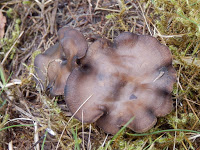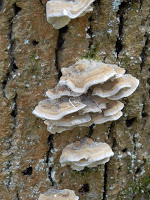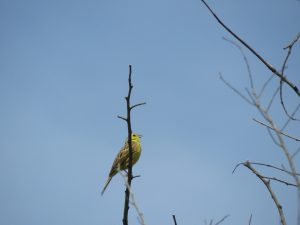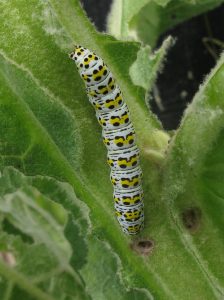Twelve of us gathered on a cool but quite sunny morning, with snow still lingering in drifts and patches from the heavy fall the previous weekend. As we set out for our morning exploration of the woodland in the vicinity of Smitham’s Chimney, we were quickly rewarded by the sights and sounds of a gathering of Siskins, Goldfinches and Bramblings amidst the branches and tops of the larches and spruces near the car park.

P.brumalis
Then, a few hundred metres down the main track, we turned right, down into the wet willow woodland where a profusion of bryophytes decorated the banks, wet hollows and tree trunks and branches. Amongst these were the tiny fuzzy growths of an unusual liverwort, Fingered Cowlwort (Colura calyptrifolia). On the other side of the track was an old moss-covered wall on which a good variety of some of the larger common species could be seen, including some beautiful cushions of Swan’s-neck Thyme-moss (Mnium hornum) covered in sporophytes. Here we also stopped to examine some coppiced hazel branches bonded together by the Glue Crust fungus (Hymenochaete corrugata) and the first of several large groups of Scarlet Elfcup (Sarcoscypha austriaca) which add such extraordinary colour to the woodland floor at this time of year.

T.ochracea (© Marion Rayner)
After lingering reflectively by the pool in front of Smitham’s chimney, our next port of call was a moss, lichen and fern-covered old wall, on the way to which we found large amounts of frogspawn lining the partly frozen puddles along the muddy track. We enjoyed lunch sitting on a bank overlooking Chew Valley Lake in the distance and, in the foreground the lead-rich ‘gruffy ground’ in which the rare and tiny Lead-moss (Ditrichum plumbicola) has one of its very few sites in the UK. Sadly, we couldn’t find it on this occasion. After lunch, we bravely ventured down the steep hill – knowing that we would have to climb back up it – to the magical hidden world of Harptree Combe.
On our way, we encountered a troop of Winter Polypores (Polyporus brumalis) growing on decaying wood, then a flock of sheep and lambs, some of whom found us of great interest. Once there, on a decaying tree trunk, we found a large gathering of Ochraceous Turkeytail (Trametes ochracea). A solitary Windflower (Anemone nemorosa) foretold of Spring to come, and amongst the luxuriant carpets and tufts of bryophytes were Big Shaggy-moss (Rhytdiadelphus triquetrus), Dwarf Neckera (Neckera pumila) and Greater Featherwort (Plagiochila asplenioides).
All that now remained for us was to climb steadily back uphill past the now disinterested flock of sheep and lambs that had distracted us with their attention on the way down. By the time we reached the car park, deep in conversation, our naturalists’ appetites had been well and truly satiated.
Alan and Marion Rayner
Photographs by Marion Rayner

Yellowhammer

Mullein moth caterpillar

Recent Comments